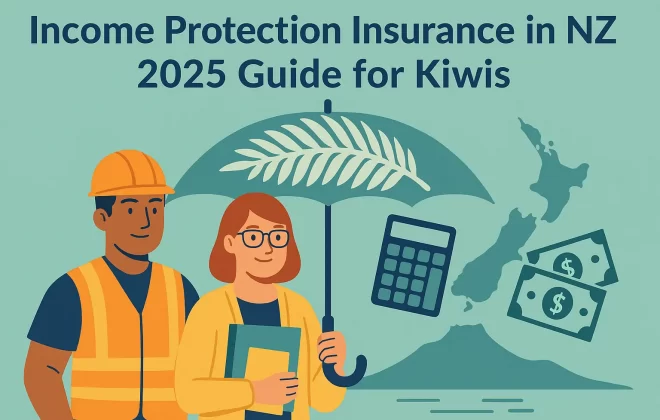Redundancy in New Zealand: Know Your Rights and Protect Your Future
Redundancy in New Zealand can strike without warning — one day you’re checking your inbox, and there it is:
A meeting invite. No context. Just the subject line: “Important Discussion Regarding Your Role”.
By midday, you’re being told your job is no longer needed, not because of anything you did, but because your company is undergoing restructuring.
Your heart sinks. You nod quietly. You wonder what happens next.
Sound familiar? You’re not alone. Thousands of New Zealanders go through redundancy every year — often without warning and rarely with a clear plan.
But here’s the truth: you still have rights, you still have choices, and you still have options.
This guide will help you understand what redundancy in New Zealand means, what you’re legally entitled to, and how to take back control, both financially and emotionally.
In this guide, we’ll cover:
- ✅ What does redundancy mean legally in NZ?
- ✅ Your rights under employment law.
- ✅ The redundancy process and what to expect.
- ✅ Where to find support (financial, legal, emotional).
- ✅ How to protect yourself from future income loss.
What is Redundancy in New Zealand?
Redundancy occurs when your employer determines that your job is no longer required. This could be due to business changes like:
● Company downsizing
● A shift in operations or location
● Outsourcing to external providers
● New technology replacing manual processes
● Mergers or acquisitions leading to duplication of roles
Importantly, redundancy is about the role, not the person. Your performance or conduct is not in question.
💡 Want to understand how to protect your paycheque from redundancy before it happens?
👉 Read our guide to Redundancy Insurance in NZ
What Makes a Redundancy “Genuine”?
Under the Employment Relations Act 2000, a redundancy must be:
- Substantiated: The employer must provide valid, documented reasons.
- Transparent: You must be consulted and given time to respond.
- Non-discriminatory: Selection must follow fair criteria (not personal bias).
If an employer fails to meet these standards, the redundancy could be challenged as an unjustified dismissal.
Example: What a Genuine Redundancy Looks Like
Case Example:
Lily, a marketing assistant at a Christchurch firm, was informed that her role was being disestablished. The company had merged with another agency, and several roles, including hers, were duplicated.
Before finalising the redundancy, her employer:
- Provided written business reasons and restructuring plans
- Offered a chance to give feedback during consultation
- Explained the selection process
- Paid out all entitlements, including 4 weeks’ notice and unused leave
✅ Because the process was transparent and well-documented, this was considered a genuine and lawful redundancy.
⚖️ Redundancy vs Dismissal: Know the Difference
Redundancy in New Zealand and dismissal are often confused, but they are distinct and have different legal and emotional implications.
Redundancy occurs when your role is no longer required, usually due to structural changes within the company. Dismissal, on the other hand, involves you being removed from a role that still exists, typically for reasons relating to your conduct or performance.
Here’s how the two compare:
| Factor | Redundancy | Dismissal |
| Reason | Business decision (not personal) | Conduct, performance, or behaviour |
| Your fault? | No decision based on company needs | Usually yes — relates to your actions |
| What changes? | The role is removed | You are removed, but the role stays |
| Compensation | Sometimes (if in contract) | Rare — only in proven unfair dismissal |
Why This Distinction Matters
Confusing the two could lead to:
- ✅ Missing out on compensation you’re owed.
- ✅ Failing to raise a personal grievance in time (must be within 90 days).
- ✅ Emotional distress — thinking you’ve done something wrong when you haven’t.
Employers are legally not allowed to use redundancy as a cover for dismissal. If your performance has never been flagged, but your role is suddenly disestablished without valid documentation, it could be a sham redundancy.
🧩 Example: Redundancy vs Dismissal in Action
Redundancy Example:
James worked as a sales coordinator at a distribution company. Due to an internal restructuring, the company eliminated his role and merged his responsibilities into another department. James was consulted, given formal notice, and received two weeks’ redundancy pay.
✅ This was a lawful redundancy.
Dismissal Example:
Aroha was let go from her role as a café manager after repeatedly missing work due to lateness and failing to meet performance standards. She had received formal warnings and opportunities to improve but didn’t meet expectations.
✅ This was a valid dismissal, not redundancy.
💡 Tip: If you’re unsure whether your situation qualifies as redundancy or dismissal, speak to a union rep, employment lawyer, or call Employment NZ for free advice.
To know more about the redundancy policy, read our article about Redundancy Insurance in NZ: Why Do You Need It?
Your Rights as an Employee
Being made redundant can be a shock, but under New Zealand law, you are protected by specific rights and entitlements. Employers must follow a fair and lawful process, and you are entitled to particular payments and documentation, as outlined in your contract.
What You’re Legally Entitled To
1. Written Notice
You must be given proper notice — typically 2 to 4 weeks, depending on what’s stated in your employment agreement or collective contract.
● This notice should be in writing, stating the reason for the redundancy and the expected final working day.
● You should not be asked to “just leave” without any documentation or warning.
2. Final Pay
You must receive a final pay cheque that includes:
● Any outstanding wages or salary
● Any unused annual leave
● Any accrued entitlements under your agreement
This payment is usually processed on or before your final day of employment.
3. Redundancy Compensation
You are only entitled to redundancy compensation if your individual or collective employment agreement explicitly provides for it.
● There’s no automatic right to redundancy compensation under New Zealand law.
● However, many larger employers or unionised workplaces include it in their agreements.
If Redundancy in New Zealand compensation isn’t mentioned in your contract, you are unlikely to be entitled to any additional payout beyond your wages and unused leave.
4. Fair Consultation Process
You have a legal right to consultation before a final decision is made.
This means your employer must:
● Notify you in advance of their proposal to disestablish your role
● Give you time to respond, ask questions, and suggest alternatives.
● Consider your feedback before confirming redundancy.
● Document this entire process.
If this doesn’t happen, the process may be legally flawed, and you could have grounds to raise a grievance.
Common Misconceptions
- “I’ve worked here for years, so I must get a payout.”
→ Not unless it’s in writing. - “If they just tell me, that’s legal notice.”
→ Not unless it’s in proper written form and aligns with your agreement.
Pro Tip
Not sure what you’re owed?
Ask your employer for:
● A copy of your employment agreement (if you’ve lost it)
● A breakdown of your final pay calculations
● Written confirmation of the consultation process
To learn more about the redundancy policy, refer to the Redundancy Insurance Guideline.
What to Do If You’re Made Redundant
Redundancy can be overwhelming, especially when it occurs suddenly. However, how you respond in the first few days can significantly impact your outcome, both emotionally and financially.
Here’s a step-by-step guide to help you take control:
Step 1: Stay Calm
It’s natural to feel shocked, frustrated, or even betrayed. But don’t rush into signing paperwork or agreeing to anything immediately.
Instead:
● Take time to process the news.
● Avoid emotionally charged decisions.
● Request a follow-up meeting or schedule a time to review the documents.
Even if your employer pressures you for a quick decision, you are allowed to pause and seek advice first.
Step 2: Request Written Confirmation
Ask your employer to provide a formal letter stating:
● That your role is being disestablished
● The business reason for the redundancy (e.g., restructure, cost savings)
● The proposed timeline for consultation and termination
● Any support being offered (e.g. redundancy pay, counselling, outplacement services)
This letter is essential for future reference — and potentially for WINZ or legal support.
Step 3: Request the Business Rationale
You have the right to ask:
● Why was your role chosen for redundancy?
● What criteria were used (e.g., seniority, department changes)?
● Were alternatives considered, like reducing hours or retraining?
● Can you confirm that this is not based on performance?
Employers must justify their decisions in a manner that is reasonable and evidence-based.
Step 4: Engage in the Consultation Process
Consultation is not just a formality — it’s a legal step that must be genuine.
Here’s what to do:
● Speak up — ask respectful but direct questions
● Request supporting documentation (e.g., restructuring plan, new org chart).
● Invite a union representative or employment advocate to attend meetings.
● Suggest possible solutions like:
● Redeployment to another team
● A temporary leave of absence
● Part-time or reduced hours
Employers must consider your feedback before finalising the decision.
Step 5: Document Everything
Keep a personal record of:
● Emails and messages related to the redundancy
● Meeting notes (take your own or request summaries)
● A copy of your employment agreement
● Dates of all communication, meetings, and notices
This documentation could be vital if:
● You need to challenge the process
● You’re applying for Jobseeker Support. You need to prove eligibility for other support (e.g., redundancy insurance).
📞 If something feels off, seek advice early from Employment New Zealand
What About Government Support?
If you’re made redundant in New Zealand, you may be eligible for Jobseeker Support through Work and Income (WINZ). It’s a crucial safety net — but one that comes with limitations.
Here’s what you should know:
● Payments are modest (often under $400/week)
● You may have to wait 1–2 weeks or more to receive support.
● It’s means-tested, so if your partner earns too much, you might not qualify.
● You will need to provide financial records, ID, and, in some cases, a redundancy letter.
🧠 Many Kiwis are surprised by how long it takes to get help and how limited its coverage is.
WINZ can help you stay afloat, especially with rent or grocery support, but it won’t replace your income or cover long-term expenses.
📌 Tip:. For more information about redundancy in New Zealand, visit Work and Income.
Want to go beyond WINZ?
If you’re already thinking about backup plans, here’s how redundancy insurance fits into the picture.
Mental & Financial Wellbeing
Redundancy doesn’t just affect your income — it affects your sense of stability.
Many Kiwis describe the early days as uncertain, isolating, and overwhelming. But the first steps you take — even small ones — can start to rebuild your confidence.
🔹 Create a basic weekly spending plan focused on essentials.
🔹 Talk to someone — it could be a friend, mentor, or professional.
🔹 Do one productive thing a day: tidy your CV, email a recruiter, research a course
🔹 Stick to routines: wake, move, rest, eat
“I didn’t realise how much I needed structure until I lost mine.” — Tama, 45, Site Manager
💬 Planning ahead doesn’t need to be overwhelming. It just needs to start.
Tips to Stay Grounded and Resilient
Redundancy doesn’t just take away a paycheque — it shakes your identity, stability, and rhythm.
Here’s how to keep yourself anchored:
● Build a calm financial zone
→ Don’t stress over long-term plans. Focus on what needs to be paid this week.
● Connect, don’t isolate
→ It’s tempting to withdraw, but one conversation can change your perspective.
● Move forward gently
→ Tidy your CV, refresh your profile — even if you’re not ready to apply.
● Design your days
→ Even a simple routine (wake, walk, eat, rest) restores mental clarity.
💬 “When I couldn’t control my job, I focused on controlling my mornings. That gave me peace.” — Anika, 42
💬 Real Kiwi Stories
“I was made redundant during COVID. It hit hard, but I stayed focused on what I could control — updating my CV and tracking my expenses. I found a new job in 6 weeks.”
— Lisa, 34, Hospitality Manager
“I didn’t realise my contract didn’t include redundancy pay. I assumed it was standard. I won’t make that mistake again.”
— Jared, 41, Logistics Supervisor
🧠 Redundancy can shake your confidence, but having a plan restores your sense of control. Compare income protection and select the best redundancy provider from Compare Income Protection.
Planning? We’ve Got Tools to Help
If you’ve already started thinking about how to reduce the stress next time, our platform is built to help:
- ✅ Explore the plan about Redundancy in New Zealand and Coverage Options.
- ✅ Learn the Difference Between Income Protection and Redundancy Cover.
- ✅ Compare Policies from Trusted NZ Providers.
Don’t wait until it happens again. Prepare now, and protect your peace of mind. Compare income protection here.
Frequently Asked Questions about Redundancy in NZ
- Can I be made redundant without notice?
No — employers must follow a consultation process and give notice based on your agreement. - What if I’m offered another role I don’t want?
You don’t have to accept a job if it’s significantly different in terms of pay, duties, or location. - Can I challenge a redundancy decision?
Yes — if the redundancy isn’t genuine or the process is unfair, you can file a personal grievance. - Is redundancy the same as being fired?
No — redundancy is about the role being removed, not your performance. - Does redundancy automatically come with a payout?
No compensation is paid if it’s included in your contract or collective agreement. - Can I still receive Jobseeker Support if I have already received my payment?
WINZ will assess your payout, savings, and household income to make an informed decision. - What’s the best way to protect myself from future job loss?
Plan — understand your rights and consider redundancy insurance options.
Take 2 minutes to get personalised quotes. Compare Redundancy Insurance Today
✅ Final Step: Know Your Rights, Protect Your Income.
Even when handled lawfully, redundancy can leave you without pay for weeks or months.
Be proactive:
● Know your rights
● Ask the right questions.
● Put backup protection in place.
✅ Compare Redundancy Insurance Today
✅ Understand Policy Features & Costs
Latest Post
- Income Protection Insurance vs Life Insurance Policy in New Zealand
- Why Are Income Protection Claims Denied? Common Pitfalls Explained
- How to Choose the Best Income Protection Policy in New Zealand
- Income Protection vs Critical Illness Cover: Best Choice for Kiwis
- Income Protection Myths Debunked: What Every Kiwi Needs to Know





